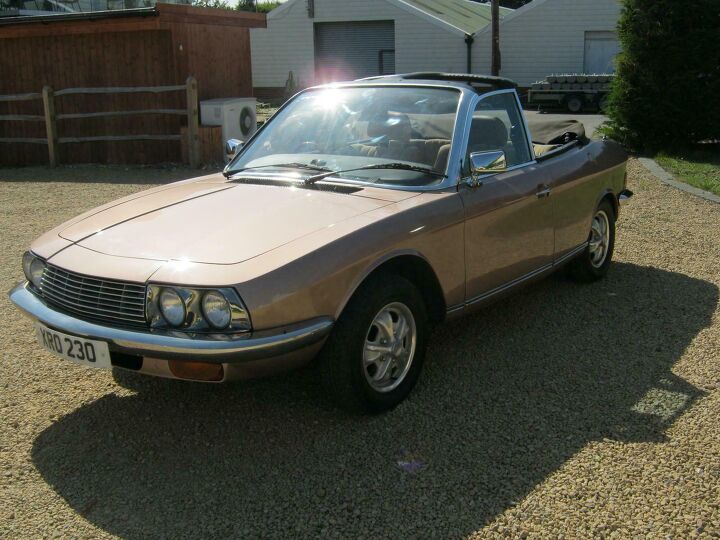Rare Rides: A 1974 NSU Ro 80, in Convertible Form

Today’s Rare Ride was a relative revolution at the time of its introduction. With smooth, aerodynamic styling and a rotary engine, NSU’s Ro 80 made big promises. Years later, one man decided he’d create the convertible that was missing from the Ro 80 lineup. Let’s check out this one-of-two NSU.
We’ve previously touched on the history of NSU in a four-part series on the Wankel-powered Spider from 1965. NSU continued its development of rotary power, and shortly after the Spider the company introduced the considerably more modern Ro 80. NSU was at the end of its independence around the time the new sedan debuted; two years later, the company merged with the Auto Union. And that organization subsequently merged with, and was crushed by, VW-Audi. The Ro 80 was then the first and last modern NSU sedan.
Introduced in 1967, the Ro 80 was marketed to wealthy customers as an executive sedan. Available in four-door format only, smooth styling covered a bevy of advanced technology. Ro 80 was front-wheel drive, powered by a 113-horsepower Wankel engine of 995 cc displacement. A single transmission greeted buyers: the ever-obscure semi-automatic. Three manual speeds with synchromesh were operated by an automatic clutch. That meant a traditional gear lever shifted by the driver, who touched a knob on the lever to activate the vacuum-operated clutch.
Steering was electrically assisted and used a ZF rack and pinion design. Other important advanced technology included four-wheel disc brakes mounted inboard at the front, and an all-independent suspension. Said suspension was modern for its time, utilizing a MacPherson layout at the front and semi-trailing arm in the rear.
All the advanced tech was great, but unfortunately NSU was not prepared for the issues which came along with its rotary engine design. The free-revving Wankel was overworked by zealous drivers, and after 1971 an audible warning was installed to let customers know when their engine was operating in the danger zone. Even if not stretched to the max, early engines had build quality and reliability issues. Many failed and required a rebuild before 35,000 miles. The problem was the motor’s rotor tip seals, which had to be redesigned to prevent internal leaks.
NSU’s engineers worked quickly, solving most of the Ro 80’s bugs by 1970. But by then dealer and consumer pressure had lead to a longer warranty on all cars, and it hurt the company’s reputation and wallet. No matter, as the Auto Union had taken hold and NSU was not long for the world. The Ro 80 continued in production at Neckarsulm through 1977. After that point, NSU was finished, and the factory was converted to Audi production. Today it makes the A6, A7, A8, and R8.
Today’s Rare Ride lived the first 15 years of its life as a standard sedan before it transformed at the hands of an Ro 80 specialist mechanic. Said mechanic desired a convertible NSU, and set to work in 1990 turning a four-door sedan into a two-door cabriolet. Another Ro 80 collector saw the drop-top and thought it an excellent idea. He hired the mechanic to build another in 1991. That’s where our beige Rare Rides Ro comes in — it’s the second of two converted. Yours for $13,000.
[Images: seller]

Interested in lots of cars and their various historical contexts. Started writing articles for TTAC in late 2016, when my first posts were QOTDs. From there I started a few new series like Rare Rides, Buy/Drive/Burn, Abandoned History, and most recently Rare Rides Icons. Operating from a home base in Cincinnati, Ohio, a relative auto journalist dead zone. Many of my articles are prompted by something I'll see on social media that sparks my interest and causes me to research. Finding articles and information from the early days of the internet and beyond that covers the little details lost to time: trim packages, color and wheel choices, interior fabrics. Beyond those, I'm fascinated by automotive industry experiments, both failures and successes. Lately I've taken an interest in AI, and generating "what if" type images for car models long dead. Reincarnating a modern Toyota Paseo, Lincoln Mark IX, or Isuzu Trooper through a text prompt is fun. Fun to post them on Twitter too, and watch people overreact. To that end, the social media I use most is Twitter, @CoreyLewis86. I also contribute pieces for Forbes Wheels and Forbes Home.
More by Corey Lewis
Latest Car Reviews
Read moreLatest Product Reviews
Read moreRecent Comments
- SCE to AUX Here's a crazy thought - what if China decides to fully underwrite the 102.5% tariff?
- 3-On-The-Tree They are hard to get in and out of. I also like the fact that they are still easy to work on with the old school push rod V8. My son’s 2016 Mustang GT exhaust came loose up in Tuscon so I put a harbor freight floor jack, two jack stands, tool box and two 2x4 in the back of the vette. So agreed it has decent room in the back for a sports car.
- Kjhkjlhkjhkljh kljhjkhjklhkjh so what?? .. 7.5 billion is not even in the same hemisphere as the utterly stupid waste of money on semiconductor fabs to the tune of more than 100 billion for FABS that CANNOT COMPETE in a global economy and CANNOT MAKE THE US Independent from China or RUSSIA. we REQUIRE China for cpu grade silicon and RUSSIA/Ukraine for manufacturing NEON gas for cpus and gpus and other silicon based processors for cars, tvs, phones, cable boxes ETC... so even if we spend trillion $ .. we STILL have to ask china permission to buy the cpu grade silicon needed and then buy neon gas to process the wafers.. but we keep tossing intel/Taiwan tens of billions at a time like a bunch of idiots.Google > "mining-and-refining-pure-silicon-and-the-incredible-effort-it-takes-to-get-there" Google > "silicon production by country statista" Google > "low-on-gas-ukraine-invasion-chokes-supply-of-neon-needed-for-chipmaking"
- ToolGuy Clearly many of you have not been listening to the podcast.
- 1995 SC This seems a bit tonedeaf.






































Comments
Join the conversation
I didn't see it in the article and am wholly unfamiliar with the creater of this contraption, but this looks more than a little French. Also, is 113hp out of ~1000ccs a good number for the period, or meh? Was this supposed to be why rotaries were so special; they could hit above their weight? What's the saying, "the power of a V6, coming from an engine the size of a 4 cylinder, with the thirst of a V8"?
I've always liked the Ro80, but this conversion is an epic failure.